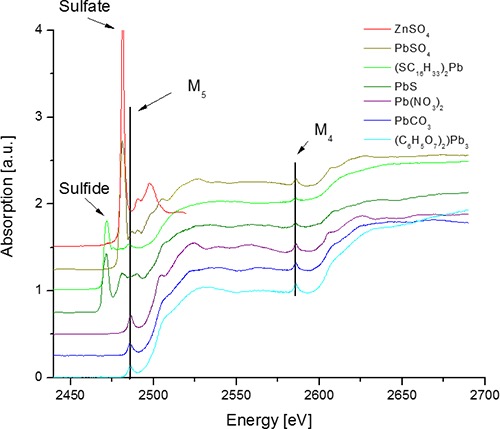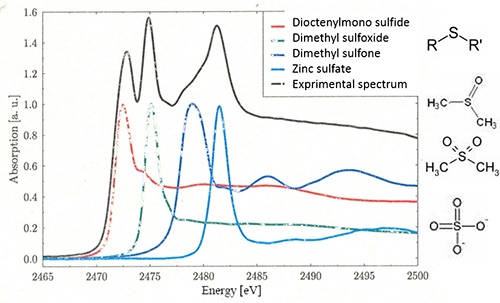CAMD Specialty: Low Energy XAS
Pb M5, 4 edge and S K-edge: When a lead compound also contains sulfur it interferes with the M-edge spectra.
 Fig. 1: XANES spectra at S K-edge (2460 to 2490 eV) Pb M5-edge (2485 to 2580 eV),
and Pb M4-edge (2585 to 2680 eV) for different compounds: top) ZnSO4 (zinc sulfate), PbSO4 (lead sulfate), middle) (SC16H33)2 Pb (lead hexadecyl-mercaptide), PbS (lead sulfide), bottom) Pb(NO3)2 (lead nitrate), PbCO3(lead carbonate), (C6O7H5)2 Pb (lead citrate).
Fig. 1: XANES spectra at S K-edge (2460 to 2490 eV) Pb M5-edge (2485 to 2580 eV),
and Pb M4-edge (2585 to 2680 eV) for different compounds: top) ZnSO4 (zinc sulfate), PbSO4 (lead sulfate), middle) (SC16H33)2 Pb (lead hexadecyl-mercaptide), PbS (lead sulfide), bottom) Pb(NO3)2 (lead nitrate), PbCO3(lead carbonate), (C6O7H5)2 Pb (lead citrate).
Low X-ray energies can be used for many different applications in all areas of scientific research: Chemical Engineering (Si, S edges), Geosciences (S edge), Biology (P, S, Cl, Ag edges), Art and Archeology (Si, P, S, Cl, Ca edges), or Environmental Sciences (many! edges). One example is Pb. On the main XAS page there is a figure showing all the absorption edges of Pb that are in the X-ray range. At CAMD the L and M edges are available for research. Fig. 1 shows how good the quality of XANES spectra at Pb M5 and M4 edge are at CAMD.
S K-edge: LCF analysis
 Figure 2: S K-edge XANES spectra of black unknown sample (i.e. rubber), red) Dioctenylmono
sulfide, green) Dimethyl sulfoxide, blue) Dimethyl sulfone, turquoise) Zinc sulfate
demonstrating Linear combination fitting
Figure 2: S K-edge XANES spectra of black unknown sample (i.e. rubber), red) Dioctenylmono
sulfide, green) Dimethyl sulfoxide, blue) Dimethyl sulfone, turquoise) Zinc sulfate
demonstrating Linear combination fitting
Linear combination fitting is one of the most used tool in XANES analysis. Fig. 2 shows in a nicely visible manner how the sum of XANES spectra of basic compounds (here different oxidation states of sulfur) can result in the XANES spectra of the unknown sample.